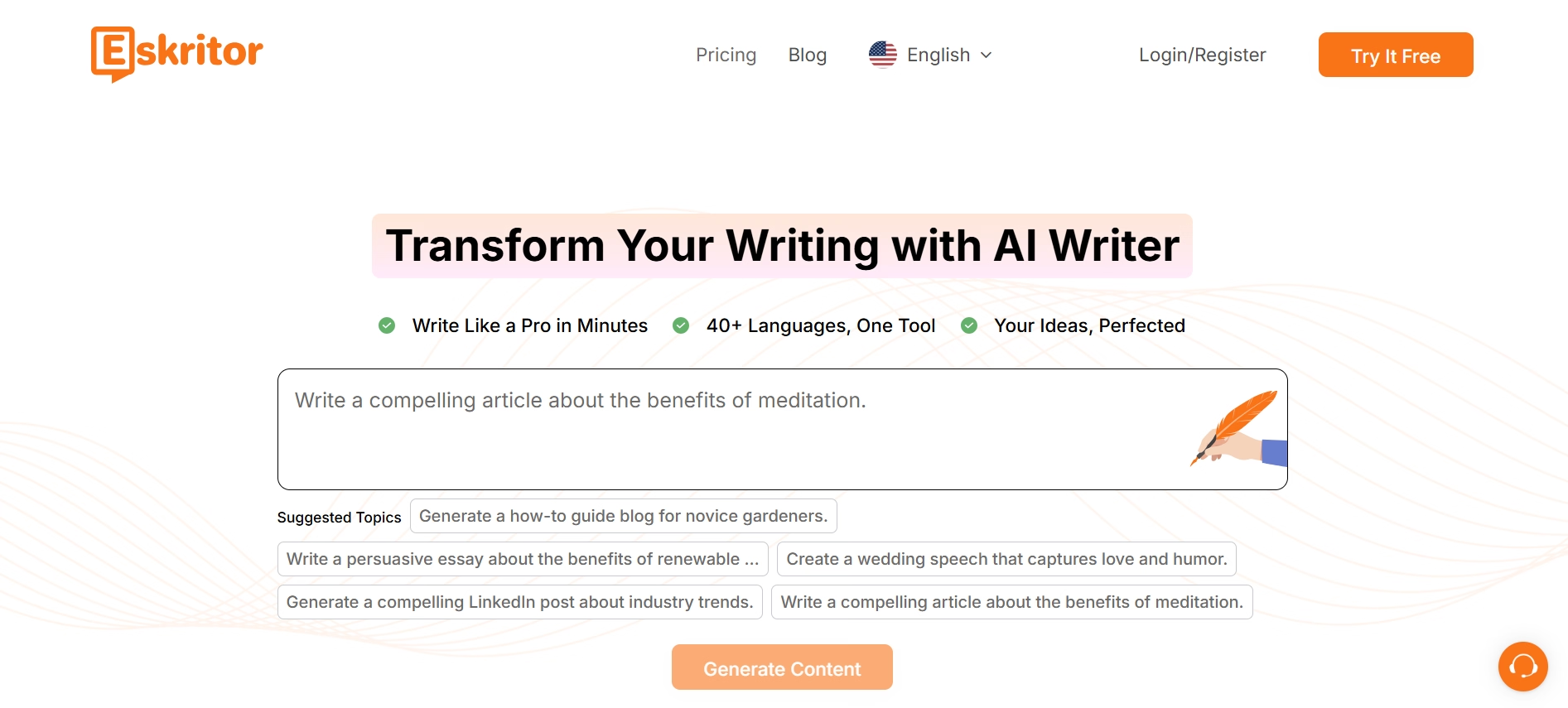
Content Style Guide in 24 Hours: Templates & Samples
Generate the Best Content with AI in Seconds
Generate the Best Content with AI in Seconds
In this guide, you'll discover how to create and implement an effective content style guide that ensures consistency across all your communications.
Whether you're a content manager, marketing professional, or part of a corporate communications team, you'll learn the essential elements of a style guide, practical implementation strategies, and tools to streamline the process.
By the end of this guide, you'll have everything you need to develop a comprehensive style guide within 24 hours.
Understanding Content Style Guides
Creating a comprehensive writing style manual and content style guide is essential for any organization that values consistent, high-quality communication. This foundational document serves as more than just a set of rules—it's a strategic tool that shapes how your brand communicates with its audience across all channels and platforms.
Content style guides serve as the foundation for maintaining consistent brand communication across all channels and teams. These living documents go beyond basic grammar rules to encompass your brand's unique voice, tone, and formatting preferences. When properly implemented, a style guide becomes the single source of truth for content creation, significantly reducing revision cycles and improving content quality.
Implementing a content style guide offers several key benefits. First, it establishes uniform standards across all channels, ensuring your brand message remains coherent whether in blog posts, social media, or technical documentation. This consistency leads to faster content production by reducing decision-making time around formatting, terminology, and style choices. Additionally, teams collaborate more effectively with a shared understanding of content requirements while the brand identity grows stronger through consistent voice and tone.

Essential Elements of a Writing Style Manual
The success of your content style guide depends on including all necessary components while maintaining clarity and usability. A well-structured manual serves as both a reference guide and a training tool, helping team members create consistent content efficiently.
Brand Voice Guidelines
Establishing a clear brand voice is fundamental to creating consistent, engaging content that resonates with your audience. This section of your style guide should provide comprehensive guidance on how your brand communicates, ensuring every piece of content reflects your organization's personality and values.
Your brand voice is the distinct personality that comes through in all your communications. A comprehensive brand voice guide should include clearly defined core attributes and tone variations. Your voice might be professional yet approachable, using clear language while maintaining expertise. It should project confidence without arrogance, sharing knowledge without being condescending.
Tone variations play a crucial role in different contexts. Consider how your voice adapts across various communication channels:
- Customer Support : Empathetic and solution-oriented tone for addressing user needs
- Technical Content : Clear and precise language that explains complex concepts simply
- Marketing Materials : Engaging and benefit-focused messaging that drives action
- Social Media : Conversational while maintaining professional credibility
Writing Conventions
The foundation of consistent content lies in establishing clear, practical writing conventions that every team member can follow. These guidelines ensure uniformity across all content while maintaining flexibility for different content types and contexts.
Every style guide needs clear writing conventions that ensure consistency. Start with fundamental grammar and punctuation standards, including specific rules for Oxford comma usage, hyphenation, number formatting, and capitalization. These foundational elements create the backbone of your content's professional appearance.
Document structure plays a crucial role in content organization. Set clear standards for heading hierarchy, paragraph spacing, and emphasis formatting. This structure ensures readers can easily navigate and understand your content, regardless of its length or complexity.
Creating Editorial Guidelines That Work
Effective editorial guidelines do more than just dictate rules—they empower your team to create better content more efficiently. This section explores how to develop guidelines that are both comprehensive and practical, ensuring high adoption rates and consistent implementation.
Setting Clear Objectives
The success of your editorial guidelines hinges on having well-defined objectives that align with your organization's broader goals. This alignment ensures that your style guide serves as a strategic tool rather than just a reference document.
Content quality metrics form the foundation of effective guidelines. Consider factors like readability scores, engagement metrics, and conversion goals when establishing your standards. These metrics should reflect your audience's needs and preferences while supporting your business objectives.
Your editorial guidelines should maintain strong brand alignment through:
- Message Consistency : Clear alignment with core brand values and messaging
- Voice Application : Practical examples of brand voice in different contexts
- Visual Standards : Guidelines for implementing brand design elements
- Audience Focus : Specific guidance for reaching target segments
Documentation Best Practices
Proper documentation ensures your style guide remains accessible and valuable over time. A well-organized system helps team members quickly find the information they need while maintaining the guide's long-term effectiveness.
Organization methods should focus on creating intuitive access to information. Group related guidelines together logically and provide quick reference sections for commonly needed details. Maintain an examples library that demonstrates real-world applications of your guidelines, helping team members understand how to implement them effectively.

Mastering Content Formatting
Proper content formatting and visual presentation enhance the impact of your content while improving user experience. This section covers essential formatting principles that ensure your content is both professional and accessible.
Visual Hierarchy
A clear visual hierarchy helps readers navigate your content efficiently while reinforcing your brand's professional image. This structure guides attention to key information and maintains consistency across all content types.
Typography forms the foundation of effective visual hierarchy. Consider font choices, size relationships, and spacing carefully to create a cohesive visual system. Your layout standards should address factors like content width, white space utilization, and image placement while ensuring responsiveness across different devices.
Digital Formatting
Modern content requires special consideration for digital platforms. Each channel has unique requirements that affect how your content appears and performs.
Platform-specific formatting ensures your content works effectively across all digital channels. Web content needs proper HTML structure and metadata, while email requires careful attention to responsive design principles. Social media platforms each have their own formatting requirements that affect how your content appears and performs.
Accessibility considerations are crucial for digital content:
- Text Alternatives : Clear descriptions for all visual elements
- Structure : Proper heading hierarchy for screen readers
- Contrast : Sufficient color contrast for readability
- Navigation : Clear link text and logical tab order
Tools and Solutions
Modern content creation demands efficient tools that streamline the style guide implementation process. The right solution can significantly improve team productivity and content consistency.

AI-Powered Writing Assistance
Artificial intelligence has transformed how teams create and maintain consistent content. Modern AI writing assistants offer advanced capabilities that make style guide implementation more efficient and effective.
Eskritor provides comprehensive AI-powered features that streamline content creation while ensuring style guide compliance. From real-time style checking to smart templates, these tools help teams maintain tone consistency and writing best practices while improving productivity.
Key benefits of using Eskritor for style guide implementation include:
- Automated Consistency : Real-time checking against style guidelines
- Smart Templates : AI-powered template customization and management
- Collaboration : Seamless team editing and review processes
- Version Control : Comprehensive tracking of document history
Implementation Strategy
Success with your style guide depends on proper implementation and team adoption. A clear strategy ensures your guide becomes an integral part of your content creation process.
Start with comprehensive team training that covers both the technical aspects of using your style guide and the reasoning behind key decisions. Regular monitoring helps identify areas where additional support or clarification might be needed.
Maintain ongoing engagement through:
- Regular Updates : Keep guidelines current with evolving needs
- Performance Tracking : Monitor impact on content quality
- Team Feedback : Gather and incorporate user input
- Continuous Improvement : Refine guidelines based on results
Conclusion
Creating and implementing a content style guide doesn't have to be a months-long project. With the right approach and tools, you can develop a comprehensive guide within 24 hours that will serve as the foundation for consistent, high-quality content across your organization. The key lies in having clear objectives, proper documentation, and efficient tools to manage and implement your guidelines.
Ready to streamline your content creation process? Start your journey with Eskritor today and experience how AI-powered assistance can transform your content style guide implementation. Create your free account and access professional templates, AI-enhanced editing, and comprehensive document management features that will help maintain consistency across all your content.
Frequently Asked Questions
An effective content style guide must include brand voice guidelines, writing conventions, editorial objectives, and formatting principles. These core components provide comprehensive guidance for maintaining consistency across all channels while allowing your brand's unique personality to shine through in every piece of content.
Creating a functional style guide in 24 hours requires focusing on the essential components: defining your brand voice, establishing basic writing conventions, and documenting formatting standards. Utilize existing templates and AI-powered tools like Eskritor to streamline the process, then refine your guide over time based on team feedback and practical application.
Eskritor's AI-powered platform automates style guide compliance through real-time checking against your defined standards, smart templates for consistent formatting, and collaborative editing features. These tools ensure your team maintains consistent tone and writing standards while significantly improving content quality and reducing the time spent on revisions.
Ensure successful adoption through comprehensive but concise training, an intuitive organization system, and plenty of real-world examples showing guidelines in action. The key is demonstrating how the style guide makes everyone's job easier—by reducing decision fatigue, streamlining approvals, and creating clearer communication between departments.





 Dubai, UAE
Dubai, UAE